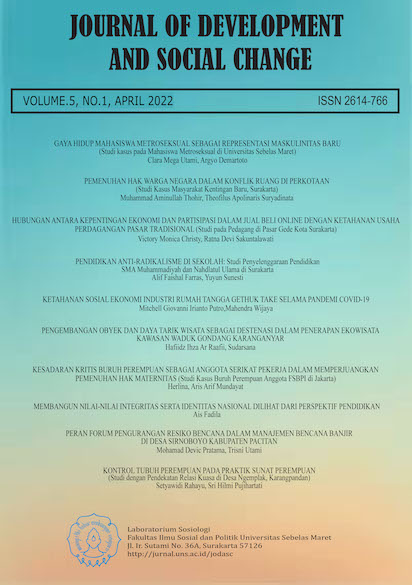PEMBINAAN KENAKALAN ANAK OLEH YAYASAN SINAI DI SUKOHARJO
Abstract
Full Text:
PDFReferences
Anonim. 2002. Undang-Undang Nomor 23 tahun 2002 tentang Perlindungan Anak. Lembaran RI Tahun 2002 Nomor 109. Jakarta: Sekretariat Negara.
Creswell, J. W. 2010. Research design: pendekatan kualitatif, kuantitatif, dan mixed. Yogjakarta: PT Pustaka Pelajar.
Fenomena Klitih, Potret Kenakalan Remaja Yang Mengkhawatirkan diakses dari https://plus.kapanlagi.com/fenomena-klitih-potret-kenakalan-remaja-yang-mengkhawatirkan-f90439.html, pada 9 November 2018
Jochnson, Doyle Paul. 1994. Teori Sosiologi Klasik dan Modern. Jakarta: Gramedia Pustaka.
Kartono, Kartini. 2014. Patologi Sosial Jilid 2: Kenakalan Remaja. Jakarta: PT. Raja Grafindo Persada.
KPAI : Riset Kekerasan di Media Picu Anak Jadi Pelaku Kejahatan tersedia di http://www.kpai.go.id/berita/kpai-riset-kekerasan-di-media-picu-anak-jadi-pelaku-kejahatan, diakses pada 9 November 2019
Miles, B. Mathew dan Huberman, A. Michael. 1992. Analisis Data Kualitatif Buku Sumber Tentang Metode-metode Baru. Jakarta: UIP.
Moleong, Lexy J. 2010. Metodologi penelitian kualitatif. Bandung: Remaja Rosdakarya.
Narwoko, J. Dwi dan Suyanto, Bagong. 2007. Sosiologi Teks Pengantar dan Terapan. Jakarta: Kencana
Simanjuntak, B., dan Pasaribu, I. L. 1990. Membina dan Mengembangkan Generasi Muda. Bandung: Tarsito.
Sugiyono. 2013. Metode Penelitian Pendidikan Pendekatan Kuantitatif, Kualitatif, dan R&D. Bandung: Alfabeta.
DOI: https://doi.org/10.20961/jodasc.v2i1.41658
Refbacks
- There are currently no refbacks.




